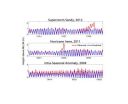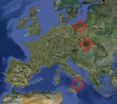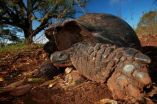(Press-News.org) Researchers at the University of Liverpool have developed a computer-based test that could help heavy drinkers reduce their alcohol consumption.
Regular heavy drinking can lead to serious health conditions such as liver and heart disease, costing the NHS millions of pounds every year. Research at Liverpool has shown that the habit of consuming alcohol can be interrupted when people practice methods of restraint whenever they see images of alcoholic drinks.
The team developed a computer test that required participants to press particular buttons when an image of alcohol or soft drink appeared on screen. They were asked to perform this task at speed, but when they heard a tone sound they were expected to stop immediately. In one group the tone was presented at the same time as alcohol pictures appeared on screen, and in another group the tone was not matched up to images of alcoholic drinks.
Following the task, participants were given the option of drinking beer. Researchers found that participants who learned to exercise restraint when alcohol images were shown subsequently drank less beer than the control groups that did not practice the same method. The team aim to develop the computer intervention for online use as part of a wider Medical Research Council (MRC) funded project on computerised interventions to boost self-control in heavy drinkers.
Professor Matt Field, from the University's Institute of Psychology, Health and Society, said: "It is thought that people who drink alcohol at unsafe levels do so because drinking behaviour has become an over-learned habit that they perform without really thinking about it. Similar to the practiced activity of brushing your teeth in the morning, a person may regularly drink a few glasses of wine with their evening meal. This kind of habit can lead to serious health problems, and in extreme cases, alcohol dependence.
"We wanted to investigate whether a person could learn to apply self-control automatically, in the hope that this might override the ingrained habit of drinking alcohol. We found that if participants repeatedly exercised self-control in response to images of alcoholic drinks, they drank less alcohol when the opportunity was later offered to them in the laboratory.
"We hope to develop this computer intervention to see whether people can use the intervention, outside of the laboratory environment, in their daily lives. This may take the form of an online activity to support those people who want to reduce their intake of alcohol."
The research is published in the journal Experimental and Clinical Psychopharmacology and can be viewed by visiting the website at: http://psycnet.apa.org/psycinfo/2012-31646-001/
### END
New test to help heavy drinkers reduce alcohol intake
2012-11-27
ELSE PRESS RELEASES FROM THIS DATE:
Paralysis by analysis should not delay decisions on climate change
2012-11-27
Uncertainty about how much the climate is changing is not a reason to delay preparing for the harmful impacts of climate change says Professor Jim Hall of the Environmental Change Institute at the University of Oxford and colleagues at the Tyndall Centre for Climate Change Research, writing today in Nature Climate Change.
The costs of adapting to climate change, sea-level and flooding include the upfront expenses of upgrading infrastructure, installing early-warning systems, and effective organisations, as well as the costs of reducing risk, such as not building on flood ...
Researcher studies 'middle ground' of sea-level change
2012-11-27
The effects of storm surge and sea-level rise have become topics of everyday conversation in the days and weeks following Hurricane Sandy's catastrophic landfall along the mid-Atlantic coast.
Ongoing research by professor John Brubaker of the Virginia Institute of Marine Science is throwing light on another, less-familiar component of sea-level variability—the "intra-seasonal" changes that occupy the middle ground between rapid, storm-related surges in sea level and the long-term increase in sea level due to global climate change.
"These are cases when the water is ...
From Mediterranean coasts to Tatra Mountains and beyond: Plant chromosome number variation
2012-11-27
Chromosome number is the most basic feature concerning the genome of a species, and it is known for about one third of higher plant species. In particular, for plants of Italy, Slovakia, and Poland, online chromosome number databases have been developed: 'Chrobase.it – Chromosome numbers for the Italian flora', 'Karyological database of ferns and flowering plants of Slovakia' and 'Chromosome number database – PLANTS', respectively. The three datasets account for about 35%, 60% and 40% of the whole floras, respectively.
"We used these datasets to compare chromosome number ...
Researchers explore social media as preventative method for infectious diseases
2012-11-27
MANHATTAN, Kan. -- When it comes to stopping illness, social media posts and tweets may be just what the doctor ordered.
A Kansas State University-led research team is looking at social media as a tool to reduce and prevent diseases from spreading. Researchers are studying whether a well-timed post from a public authority or trustworthy person could be as beneficial as flu shots, hand-washing or sneezing into an elbow.
"Infectious diseases are a serious problem and historically have been a major cause of death," said Faryad Sahneh, Kansas State University doctoral candidate ...
Man's best friend: Common canine virus may lead to new vaccines for deadly human diseases
2012-11-27
Athens, Ga. – Researchers at the University of Georgia have discovered that a virus commonly found in dogs may serve as the foundation for the next great breakthrough in human vaccine development.
Although harmless in humans, parainfluenza virus 5, or PIV5, is thought to contribute to upper respiratory infections in dogs, and it is a common target for canine vaccines designed to prevent kennel cough. In a paper published recently in PLOS ONE, researchers describe how this virus could be used in humans to protect against diseases that have eluded vaccine efforts for decades.
"We ...
Galapagos tortoises are a migrating species
2012-11-27
This press release is available in German.
The Galapagos giant tortoise, one of the most fascinating species of the Galapagos archipelago, treks slowly and untiringly across the volcanic slopes. Scientists of the Max Planck Institute for Ornithology in Radolfzell, together with the Charles Darwin Foundation, have used GPS technology and modern 3D acceleration measurements to find out that especially the dominant male tortoise wanders up to 10 kilometres into the highlands of the island. Only the fully grown animals migrate, the young tortoises stay year round in ...
Do missing Jupiters mean massive comet belts?
2012-11-27
Using ESA's Herschel space observatory, astronomers have discovered vast comet belts surrounding two nearby planetary systems known to host only Earth-to-Neptune-mass worlds. The comet reservoirs could have delivered life-giving oceans to the innermost planets.
In a previous Herschel study, scientists found that the dusty belt surrounding nearby star Fomalhaut must be maintained by collisions between comets.
In the new Herschel study, two more nearby planetary systems – GJ 581 and 61 Vir – have been found to host vast amounts of cometary debris.
Herschel detected ...
Researchers study cry acoustics to determine risk for autism
2012-11-27
Autism is a poorly understood family of related conditions. People with autism generally lack normal social interaction skills and engage in a variety of unusual and often characteristic behaviors, such as repetitive movements. While there is no specific medical treatment for autism, some success has been shown with early behavioral intervention.
Understanding the importance of early diagnosis, researchers at Women & Infants' Brown Center for the Study of Children at Risk in collaboration with researchers at University of Pittsburgh have been studying the cry acoustics ...
Flu outbreaks predicted with weather forecast techniques
2012-11-27
Contact: David Hosansky
hosansky@ucar.edu
303-497-8611
Zhenya Gallon
zhenya@ucar.edu
303-497-8607
National Center for Atmospheric Research/University Corporation for Atmospheric Research
Flu outbreaks predicted with weather forecast techniques
BOULDER – Scientists at Columbia University and the National Center for Atmospheric Research have adapted techniques used in modern weather prediction to generate local forecasts of seasonal influenza outbreaks. By predicting the timing and severity of the outbreaks, this system can eventually help health officials ...
Cell Transplantation reports islet cell advancement increases impact on transplantation
2012-11-27
Putnam Valley, NY. (Nov. 27, 2012) – A study published in the current issue of Cell Transplantation (21:8), now freely available on-line at http://www.ingentaconnect.com/content/cog/ct/ , reports that a team of researchers in South Korea have successfully engineered islet cell clusters (ICCs) that will improve pancreatic islet transplantation and offer promise for curing diabetes mellitus.
Carried out by collaborating researchers at three universities in Seoul, Korea, the new process of creating ICCs included delivering a gene to single islet cells that increased their ...





